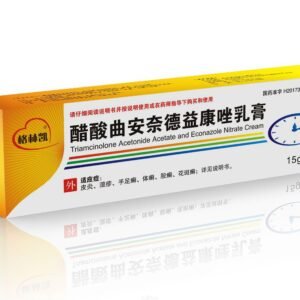triamcinolone acetonide
Effects and efficacy:
Triamcinolone acetonide injection is administered intramuscularly for allergic diseases (for patients in a severely debilitated state and when traditional drugs are ineffective), skin diseases, diffuse rheumatic arthritis, and other connective tissue diseases. Triamcinolone acetonide nasal spray is used to treat perennial and seasonal allergic rhinitis, with symptoms including nasal itching, nasal obstruction, runny nose, sneezing, etc. Triamcinolone acetonide econazole cream can be used for dermatitis and eczema with or with a tendency to fungal infection; inflammatory dermatophytes, yeasts, and molds, such as tinea manuum, tinea corporis, tinea cruris, and tinea versicolor; diaper dermatitis; candidal angular cheilitis; paronychia; mixed skin infections caused by fungi and bacteria, etc.
Usage and Dosage:
Bronchial asthma intramuscular injection, 1 ml (40 mg) per time for adults, once every 3 weeks, 5 times as a course of treatment, 80 mg can be used for patients with more severe symptoms; children aged 6 to 12 can be halved, and if necessary, children aged 3 to 6 can use 1/3 of the adult dose. Allergic rhinitis intramuscular injection, 1ml (40mg) each time, once every 3 weeks, 5 times as a course of treatment; inferior turbinate injection, first spray 1% lidocaine solution for surface anesthesia in the nasal cavity, then inject 0.5ml of this product into the front end of both inferior turbinates, once a week, 4-5 times as a course of treatment. Various joint diseases 10-20mg each time, add 10-20ml of 0.25% lidocaine solution, use a No. 5 needle, insert the needle into the lesion once, 2-3 times a week or once every other day, 1-2 times a week after the symptoms improve, 4-5 times as a course of treatment. Skin diseases are directly injected into the lesion site, usually 0.2-0.3mg per site, depending on the size of the affected area, no more than 0.5mg per site, and repeated every 1-2 weeks if necessary. Topical application: 2-3 times a day, generally once in the morning and evening. When treating dermatitis and eczema, the course of treatment is 2-4 weeks. The drug must be shaken more than 5 times before use in the nasal cavity; for children over 12 years old, adults and the elderly, the recommended dose is 2 sprays per nostril (a total of 220μg), once a day. When the symptoms are under control, the dose can be reduced to 1 spray per nostril (a total of 110μg), once a day. If the symptoms do not improve after three weeks, you should seek medical attention in time.
Adverse reactions:
Long-term use may cause disorders in water, salt, sugar, protein and fat metabolism: manifested as full moon face and body shape, weight gain, lower limb edema, purple lines, easy bleeding tendency, poor wound healing, acne, menstrual disorders, avascular necrosis of the humeral or femoral head, osteoporosis and fractures, muscle weakness, muscle atrophy, hypokalemia syndrome, growth inhibition in children, glaucoma, cataracts, benign intracranial hypertension syndrome, impaired glucose tolerance and aggravation of diabetes. Patients may experience mental symptoms: euphoria, agitation, delirium, restlessness, disorientation, and may also manifest as inhibition. Mental symptoms are particularly prone to occur in people with chronic wasting diseases and those who have had mental disorders in the past. The main adverse reactions are inducing or aggravating infections. Fungi, tuberculosis, Staphylococcus, Proteus, Pseudomonas aeruginosa and various herpes viruses are the main ones. Inducing or aggravating peptic ulcers: In addition to hindering tissue repair and delaying tissue healing, glucocorticoids can also increase the secretion of gastric acid and pepsin, reduce gastric mucus secretion, and reduce the resistance of gastric mucosa. They can induce or aggravate bleeding of gastric and duodenal ulcers, and even cause gastrointestinal perforation. Glucocorticoid withdrawal syndrome. Sometimes patients experience dizziness, fainting tendency, abdominal pain or back pain, low fever, loss of appetite, nausea, vomiting, muscle or joint pain, headache, fatigue, and weakness after stopping the drug. If adrenal cortex insufficiency and recurrence of the original disease can be ruled out after careful examination, it can be considered as a glucocorticoid dependence syndrome.
Drug contraindications:
Allergic to this product is prohibited. Use with caution during pregnancy. Use with caution during lactation. Use with caution in children. Use with caution in liver function damage. Use with caution in kidney function damage.
Share:
Products
Our offers
Health Classification
Let us work together to protect precious health






























